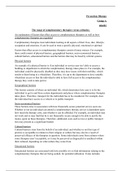Pavandeep Bhangu
Group A
606401
The range of complementary therapies versus orthodox
An explanation of factors that affect access to complementary therapies as well as how
complementary therapies are regulated
Complimentary therapies treat individuals looking at all aspects of their lives, diet, lifestyle,
occupation and emotions. It can be used to treat a specific physical, emotional or spiritual
Factors that affect access to complementary therapies consist of many sources. For example,
these could consist of physical barriers, geographical barriers, socio-economical barriers,
cultural barriers, educational barriers and the barriers that may be faced by referral systems.
Physical barriers
An example of a physical barrier is if an individual or service user isn’t able to access a
building or department in which the complimentary therapy takes place in. For example, the
individual could be physically disabled as they may have issues with their mobility, which
results in them being in a wheelchair. Therefore, it is up to the department to have suitable
wheelchair access so that the individual is able to have full access to the complementary
therapy they wish to take part in.
Geographical barriers
This barrier consists of where an individual life, which determines how easy it is for the
individual to get to and from certain departments and places where complementary therapies
takes place. Therefore, transport for the individual has to be considered. For example, does
the individual have access to a vehicle or to public transport.
Socio-economical barriers
These barriers arise in association with how financially secure potential service users are.
Whether or not an individual can attend a complementary therapy service is dependent upon
how much the therapy costs, and whether it can be afforded. For example, an individual may
not work and so may find that he is not financially secure enough to be able to justify the
money spent on these therapies. Therefore, additional costs such as taxi or public transport
fees may present as a significant burden
Cultural barriers
Cultural barriers stem from the beliefs of an individual, and whether or not this type of
practice is acceptable in relation to their religion or culture but may also be a result of
perceived efficacy of the therapies in question. Some individuals come from cultures where
some therapies aren’t acceptable, as it may be perceived as disgraceful or unethical within
their cultured, depending on what culture they come from.
Educational barriers
Educational barriers are associated with how possible it is to find information relating to the
complementary therapies that are being seeked, for potential utilisation. It also includes
,finding out what is seen to work best to aid with particular conditions, what doesn't
necessarily work effectively, how it works and what it aims to achieve
Acupuncture
Acupuncture is a form of alternative medicine in which thin needles are inserted into the
body. Acupuncture usually costs £35-£70 which is a little expensive. It is used to treat other
musculoskeletal conditions (of the bones and muscle) as well as pain conditions including
chronic pain, such as neck pain. Furthermore, it is also used to treat arthritis. Many
individuals use acupuncture as it creates longer lasting pain relief. Furthermore, an advantage
of acupuncture is that it improves the body’s functions and promotes the natural self-healing
process. However, a disadvantage of acupuncture is that some of the ide effects can include
soreness as we as minor bleeding or bruising where the needles are being inserted. Therefore,
individuals with bleeding disorders cannot use this treatment which acts as a barrier, which is
also a factor that affects access to acupuncture. Arthritis is an example in which acupuncture
can treat as the needles connect to the meridians, therefore it stimulates these points, which
corrects the flow of IQ and alleviates pain. Acupuncture is regulated by the British
acupuncture council. Acupuncture can be accessed through anyone who is a member of the
British acupuncture council, therefore it is easily accessible.
, Hydrotherapy
Hydrotherapy is using water in the treatment of different conditions, which is usually done in
a hydrotherapy pool where the water is heated and has an affect on your body. The hot water
relaxes your muscles which causes sweating which can be used to treat various disorders such
as arthritis, rheumatism as well as poor blood circulation and sore muscles. Furthermore, an
advantage of hydrotherapy is that it can soothe sore and inflamed muscles as well as joints
which relieves pain. Hydrotherapy is also known to lower fevers, soothe headaches and
promote relaxation, which gets rid of stress. However, some disadvantages of hydrotherapy
are that overheating can occur if an individual decides to spend too much time in the
hydrotherapy pool. Individuals are also at risk of contaminating diseases as you will be in
water, therefore some people are at risk of contracting UTI’s, tinea, pedis and plantar warts.
This can act as a barrier as individuals who have athletes’ foot, for example aren’t able to
take part in this treatment as it is can contaminate other people. An example in which
hydrotherapy can treat is rheumatoid arthritis. As rheumatoid arthritis causes inflammation in
the joints, causing stiffness, swelling redness and pain, people who use hydrotherapy have to
take part in special exercises that you do in warm water, which allows your muscles to relax
as it easies the pain in your joints as hydrotherapy exercises increases the range of movement
of your joints. Furthermore, a session of hydrotherapy can cost £40-£60 which is affordable.
To access hydrotherapy, you can be referred by the NHS or you can access it by arranging a
private session online, which means it is easily accessible. However, if an individual doesn’t
earn enough money, they may not be able to treat themselves for a private session.
Art therapy
Art therapy is a creative method of expression, which is used as a therapeutic technique.
Forms of art therapy is using your imagination and creativity to draw or paint art through
self-expression. Art therapy can help improve symptoms which are related to mental and
physical disorders, Furthermore, it can also reduce emotional pain, stress, eating disorders as
well as irritability levels during recovery. An advantage of art therapy is that it helps build the
self-awareness as well as self-esteem necessary to tackle various social situations and life
challenges. For example, it enables an individual to overcome situations where an individual
may be stressed such as during an individual’s exams. Art therapy doesn’t have any
disadvantages; however, its barriers include people who have arthritis in their arms and
fingers who aren’t able to use art therapy as they can’t physically draw or paint. Stress is n
example in which art therapy can treat as it promotes health and wellness. Therefore, self-





